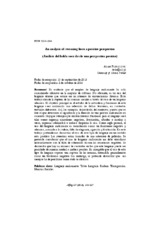Mostrar el registro sencillo del ítem
An analysis of swearing from a positive perspective
| dc.contributor.author | Pluszczyk, Adam | |
| dc.date.accessioned | 2016-11-30T11:19:39Z | |
| dc.date.available | 2016-11-30T11:19:39Z | |
| dc.date.issued | 2015 | |
| dc.identifier.issn | 2386-9658 | |
| dc.identifier.uri | http://hdl.handle.net/10396/14113 | |
| dc.description.abstract | Es evidente que el empleo de lenguaje malsonante ha sido considerado ofensivo en la mayoría de culturas. No obstante, es un uso del lenguaje ubicuo que ocurre en un número de circunstancias diversas. Este trabajo aborda la ruptura de las normas sociales a través del uso de un lenguaje ofensivo. El objetivo principal es el estudio de la naturaleza y funciones de este lenguaje soez analizando una selección de dichos términos, en contextos textuales diferentes. Así, los ejemplos dependerán del contexto; puesto que es éste el que determina el significado y la función de una palabra malsonante en concreto. Hay que subrayar que existen diversas funciones para el lenguaje soez tales como expresar emociones negativas, frustración, ofender o insultar a otros, expresar solidaridad o incluso despertar la risa. Como regla general, el uso del lenguaje malsonante es considerado como un fenómeno negativo y ofensivo, asociado a la rudeza, falta de elegancia, agresión y frustración. En este trabajo pretendemos demostrar el uso de este tipo de lenguaje en un sentido más positivo. Las muestras están tomadas de una selección de películas. Se pretende corroborar que el uso de lenguaje malsonante no debe vincularse necesariamente con la falta de educación ni con las emociones negativas. Se demuestra que hay un número de contextos en los que este lenguaje puede ser percibido de manera neutral o incluso positiva. Es innegable que el uso de este tipo de lenguaje supone una ruptura de las normas, entendida generalmente como un fenómeno negativo. Sin embargo, se pretende demostrar que no siempre ha de percibirse como rudo u ofensivo. | es_ES |
| dc.description.abstract | It is undeniable that in most cultures, swearing has always been regarded as offensive. However, it is ubiquitous as it occurs in a number of various circumstances. The following paper concentrates on the violation of the social norms through offensive language – that is swearing. The primary objective is to concentrate on the nature and functions of swearing and analyze selected swear words in a number of various contextual settings. Hence the examples will be context-dependent as it is the context which determines the meaning and the function of a particular swear word. It should be emphasized that there are several functions of swearing, such as venting negative emotions, frustration, offending or insulting others, showing solidarity and even bringing forth laughter. It is common knowledge that generally, swearing is considered to be a negative and offensive phenomenon as it is associated with rudeness, impoliteness, insensitivity, aggression and frustration. In the following article we will attempt to demonstrate the occurrence of swearing used in a more positive sense. We will deal with selected examples of swear words and various functions of swearing in a number of communicative events and will indicate a positive nature of swearing. Our analysis is based on the examples taken from selected movies. We intend to demonstrate that swearing does not always have to be associated with impoliteness, lack of good manners and negative emotions. Instead we will show that there are a number of contextual settings in which swearing can be perceived neutrally or even positively. It is undeniable that the very act of swearing causes violation of the norms, which is usually considered to be a negative phenomenon. Nevertheless, we will attempt to indicate that it does not always have to be perceived negatively or regarded as rude or offensive. | es_ES |
| dc.format.mimetype | application/pdf | es_ES |
| dc.language.iso | eng | es_ES |
| dc.publisher | UCOPress | es_ES |
| dc.rights | https://creativecommons.org/licenses/by/3.0/ | es_ES |
| dc.source | Alfinge 27, 103-127 (2015) | es_ES |
| dc.subject | Lenguaje malsonante | es_ES |
| dc.subject | Tabú | es_ES |
| dc.subject | Lenguaje | es_ES |
| dc.subject | Rudeza | es_ES |
| dc.subject | Transgresión | es_ES |
| dc.subject | Normas Sociales | es_ES |
| dc.subject | Swearing | es_ES |
| dc.subject | Taboo | es_ES |
| dc.subject | Language | es_ES |
| dc.subject | Impoliteness | es_ES |
| dc.subject | Violation | es_ES |
| dc.subject | Social Norms | es_ES |
| dc.title | An analysis of swearing from a positive perspective | es_ES |
| dc.title.alternative | Análisis del habla soez desde una perspectiva positive | es_ES |
| dc.type | info:eu-repo/semantics/article | es_ES |
| dc.relation.publisherversion | https://www.uco.es/ucopress/ojs/index.php/alfinge/index | es_ES |
| dc.rights.accessRights | info:eu-repo/semantics/openAccess | es_ES |

